Restoring Functional Gait
Learn something now! - Watch the Online CEU Course Trailer

All Access Online CEU for PT, PTA and OT for $189
BEST VALUE - Includes this course and all our online courses
Subscribe Todaytheaters Purchase Now, Instant Online Course Access
Restoring Functional Gait
$200.00
- CE Hours: 13.0 hrs, 1.3 CEU
- Delivered: Online
- Instant Online Access, 365 days of access, Mobile Ready
- No auto-renewal for this option
All Access Online CEU for PT, PTA and OT
$189
All Access Online CEU for PT, PTA and OT Subscription
1 Year Access with Annual Renewal
State specific course completion certificates.
Chat support
Prices are in US dollars- 12 months of access to all online ceu courses, course tests and state approval certificates.
- Meet all your CE requirements. Pre-approved for PT, PTAs in AK, AL, AZ, CA, CO, CT, DC, DE, GA, HI, IA, ID, IL, IN, KS, MA, ME, MI, MO, MS, MT, NC, ND, NE, NH, NM, NV, NY, OR, PA, RI, SC, SD, TN, TX, UT, VA, VT, WA, WI, and WY.
- AOTA approved.
- Designed for Physical Therapists, Occupational Therapists, Athletic Trainers and Assistants.
- Access to future courses and content.
- Start, stop and resume, right where you left off in a course.
- Real patient interviews.
- Medical expert contributors.
- 3D anatomy and medical illustrations.
- Easy to use learning system for fast access to your courses.
- Award winning content.
- Top instructors teaching evidence based skills and techniques.
Why should a physical therapist, physical therapy assistant or athletic trainer take this gait analysis physical therapy continuing education course?
What is gait training? Functional gait patterns require the synergy between balance, coordination, range of motion, and strength. A "normal" walking pattern is different for each person, depending on their specific needs. The key is to identify deficits that contribute to abnormal gait patterns and buildeach system appropriately. This course’s systematic approach will enhance differential diagnosis skills when assessing gait patterns and assist with developing comprehensive rehabilitation programs designed to improve functional gait at home and in the community.
Rehab clinical tools instructed in this gait training physical therapy course to enhance your functional outcomes.
- Information and skills needed to promote energy efficiency with gait and activities.
- Differential diagnoses skills for analyzing, communicating, and progressing the client to a more functional level of movement.
- Systematic evidence-based assessment and treatment techniques.
- Task analysis to help identify components to isolate movements of specific tasks.
Specific instruction that will enhance your understanding of gait and your ability to create effective treatment programs based on specific gait related issues.
- Phases of gait and factors that contribute to dysfunction are addressed in order to differentiate problematic sources contributing to gait dysfunction.
- Techniques to apply to many pathologies in both the neurologic and orthopedic realm (including, but not exclusive to, CVA, SCI, TBI, Parkinson’s Disease, MS, CP, deconditioning, hip pathologies, arthritis).
- Physician discussions promote the importance of understanding how comorbidities can affect gait and tips on addressing specific treatments, gait training exercises, techniques, and products are provided to help improve gait and function.
Features unique to this gait training physical therapy course.
- Patient presentations, gait analysis, gait training exercises and rehab techniques are filmed with studio-quality, multi-camera angles. 3D animations of the gait cycle and musculature enhance the learning experience when identifying important musculoskeletal components in normal and dysfunctional movement.
- Six case presentations include patients with the diagnosis of Parkinson’s, spinal tumor, Achilles tendinitis and Parkinson’s, bilateral LE edema, s/p stroke with shoulder subluxation, neuropathy, lymphedema, and a spinal fracture. Each case is discussed from a functional approach, and recommendations are discussed and demonstrated to improve dysfunctional movements.
- Multi-Camera gait analysis provides an enhanced learning experience when observing varying gait patterns.
- 3D animations and anatomy images enhance understanding of the gait cycle and analysis.
Related continuing education courses
Professional Accreditation
This is an intermediate level course applicable for PT, PTA, OT, AT. Physical Therapy Accreditation: For specific state information use the accreditation verification menu and select your state of license. AOTA: provider #4487, Intermediate level occupational therapy process: evaluation and treatment. Athletic Trainers: BOC provider #P2047, category A. This course has not been submitted for Evidence-Based BOC approval.
fact_check Accreditation Verification
Online CEU Course for PT, PTA, OT State Accreditation
Chapter Details and Course Objectives for this Gait Training Physical Therapy Course
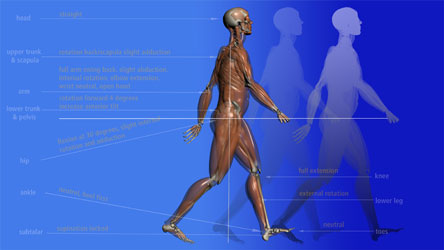
Upon successful completion of this course, the participant will be able to:
- Identify musculoskeletal dysfunction that contributes to gait abnormalities.
- Discuss normal joint motion throughout the kinetic chain through the phases of gait.
- Identify evidence-based practices for best rehab outcomes with specific diagnoses.
- Identify contributors to abnormal movement patterns.
- Discuss the movement analysis model, the purpose and usefulness when developing effective rehab tasks and programs.
- Discuss comorbidities and the impact each on gait function.
- Identify how gait impacts ADLs and community participation and develop techniques to assist patients to function within community
- Differentiate specific musculoskeletal and neurological dysfunction leading to gait dysfunction.
- Systematically analyze gait abnormalities and prioritize treatments focused on improving function.
- Analyze movement patterns associated with specific tasks that involve gait.
- Develop task-specific treatment plans and gait training exercises to improve functional gait.
- Identify upper extremity factors that contribute to gait dysfunction and develop techniques to address upper extremity.
Learn From the Expert - Kimberly A. Contryman, PT, DPT, NCS, OCS
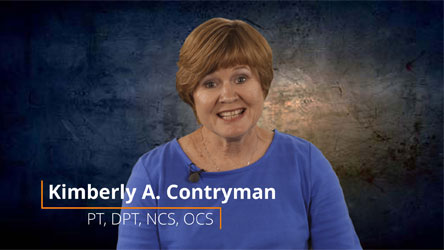
Kimberly A. Contryman, PT, DPT, NCS, OCS earned her masters of physical therapy in 1991 from Northern Arizona University. She was NDT certified in 1995, received her certification as a neurology specialist by the APTA in 2000 and received her certification as an orthopedic specialist in 2002. In May of 2002 the University of Southern California awarded Kim a doctorate of physical therapy.
Learn More about Kim ContrymanThe Science and Biomechanics of Gait
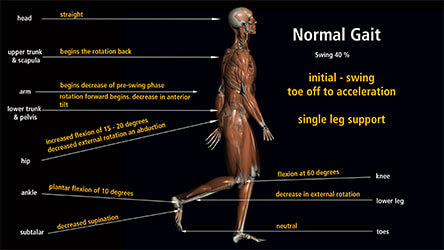
Analyzing gait, evidence based practice, normal phases of gait, lower trunk and pelvis, upper trunk
What is gait training?
- Analyzing gait
- Evidence based practice
- Normal phases of gait
- Lower trunk and pelvis
- Upper trunk
- Elomotus® Muscle Technology Animations of the Gait cycle
Muscle Activity in Gait - Elomotus® Muscle Technology
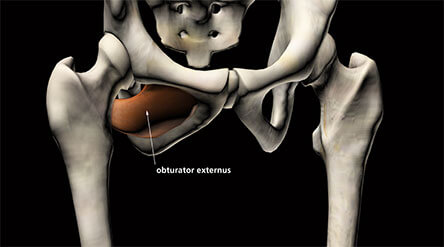
- Understanding muscle function during gait
- Exploring and understanding the function of muscles
- gluteus maximus
- hip adductors
- abductors
- tfl
- quads
- hamstrings
- triceps surae
- tibialis anterior
- toe extensor
Neuroanatomy and the Gait Cycle
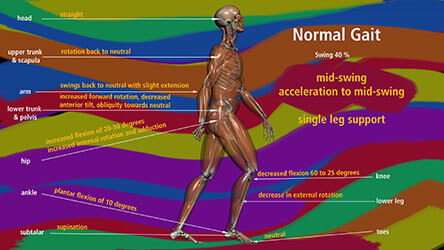
Multi-sensory information such as visual and vestibular sensation work together so that functional gait can be achieved.
- Corticospinal tracts
- Rubrospinal tract
- Reticulospinal
- Vestibulospinal tract
- Tectospinal tract
- Medial longitudinal fasciculus
- Brainstem
- Cerebellum
- Cerebrum
- Frontal lobe
- Parietal lobe
- Temporal lobe
- Occipital
Investigate the neuro shoulder and its impact on the gait cycke
Functional Gait Movement Analysis
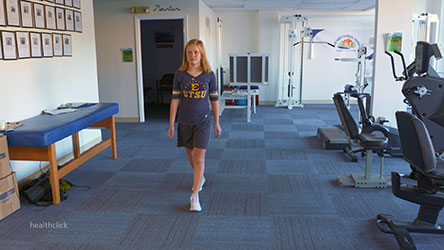
- Training for function, efficiency
- Creating treatment plans, prioritizing, task analysis
- Common gait abnormalities with neuro patients
- Contributors to abnormal movement, posture, balance, risk for falls
- Everything is connected, pelvis, hip, lumbar spine, foot and ankle
- Movement and task analysis lab demonstrations
- Breaking down components from sit to stand from observing posture
- Discussing sitting posture and translation to movement
Podiatrist Interview - Factors And Diagnoses Affecting Gait and Gait Training
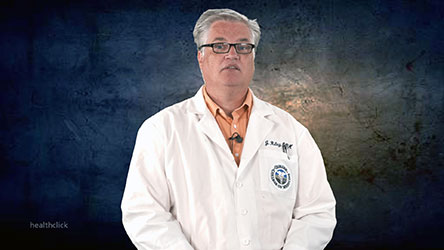
- Understanding foot biomechanics and gait training
- Neuropathy and its effect
- Understand the causes of neuropathy and approaches
- Therapy for patients with neuropathy
- The importance of proper eval, balance training, home analysis, and communication
- Big toe joint problems, bunions, secondary back issues, surgical options and risks
- Shoe options how to assess a proper shoe for proper gait
- Orthotics in the shoe - pro or con?
- Cortisone injections for arthritis
- Understanding plantar fasciitis
- Understanding ankle-foot orthosis, and orthotics
- Rigid orthotics are they beneficial?
General Surgeon - Discussion of Comorbidities and Gait Training Physical Therapy
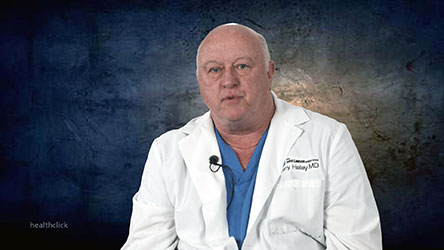
- Oncology patients, chemo side effects, diabetes
- Deconditioning and amputation
Case Presentation - L1 Burst Fracture
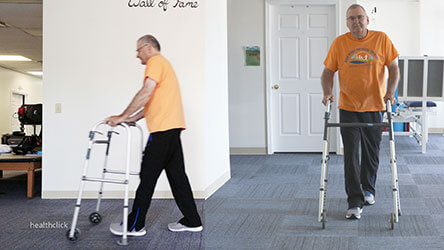
- Subjective and objective analysis of the gait pattern
- Multi-cameras view of gait cycle with AFO, walker and assistive devices
- Therapeutic gait exercises for specific patient gait abnornmalities
- Use of PNF techniques to enhance gait
Case Presentation 2: Lymphedema Bilateral Lower Extremity Cancer, Chemotherapy And Radiation
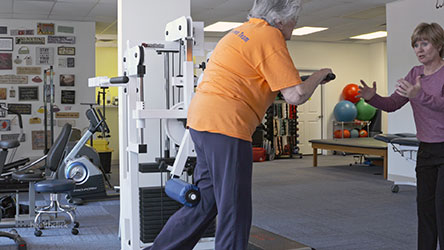
- Patient Interview concerning the treatment process
- Subjective and objective analysis specific to the diagnosis
- Gait analysis and training with walker and AFOs
- Gait training with cane while wearing AFO
- Patient discussion of braces and there impact.
- Discussion of brace type and reason for the specific bracing
- Gait analysis with walker and without braces
- Therapeutic exercises while wearing braces: balance with ball, UE dissociation
- Therapeutic exercises using gym equipment to increase strength to improve functional status, building endurance and stamina
- Therapeutic exercises for the upper extremity to enhance gait along with core strengthening
- Therapeutic exercises using the hip machine, gluteus medius strengthening, endurance training for hip musculature
Case Presentation 3: Spinal Tumor

- A discussion with the patient concerning alternate treatments
- Subjective and objective analysis specific to the diagnosis
- Gait without cane
- Ankle-foot orthosis and AFO description
- PNF techniques, muscle activation
- Therapeutic gait exercises using the gluteus medius and gluteus maximus
Case Presentation 4: Parkinsons Disease
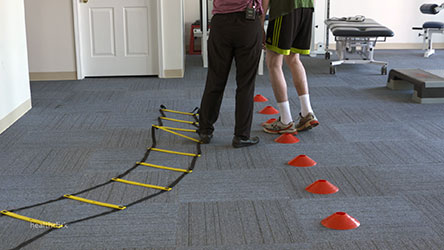
- Case Study review for patients with Parkinsons Disease with regard to gait training, exercise and rehab
- Subjective and objective gait analysis specific to Parkinsons Disease
- Therapeutic exercise for gait training for Parkinson patients including gait balance exercises
- Patient Interview detailing the challenges and success of this patient
- The effectiveness of Tai Chi for functional gait physical therapy
- Changing speed of gait for enhanced gait analysis
Case Presentation 5: Stroke Patient, Fibromyalgia, Subluxation, Lower Extremity Swelling

- Performing transfers with stroke patients
- Gait analysis with hemi walker
- Gait training with support for upper extremity
- Therapeutic exercise - sit to stand
- Gait training pearls for this patient population
- Understanding gait abnormalities/treatment
Case Study 6: Parkinson’s Gait, Task Analysis, ADL’s, Community Programs to improve Coordination and Balance
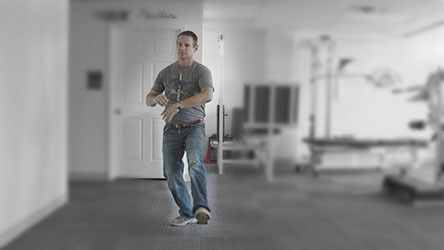
- Gait analysis
- Tasks to decrease anxiety and tremors
- Tai Chi
- Altering gait speed for detailed analysis and rehab
- Task analysis of Gait related activities
Exercises and Manual Therapy To Enhance Gait Function
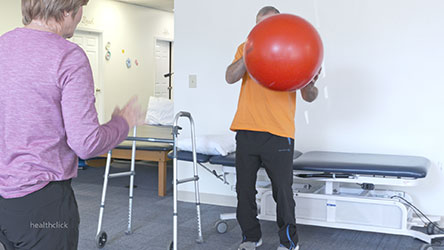
- Incorporating therapeutic exercise - quadruped
- Therapeutic exercise exercises in kneeling
- Manual therapy for hemi shoulder
- Using balance tests, scales, blood flow resistance training
Course Test - Evaluate your knowledge

- Use the Healthclick proprietary online education system which provides the online student with:
- Worldwide access to high definition video, anatomical animations and images, and written information
- The highest quality film in the industry, you can see the difference!
- Stop and resume within a course, the Healthclick system will optimize your course based on your device, connection and remembers where you left off.
- Real-time course updates. We are always adding to each courses, updating content, adding animations, these are not static courses!
- Evaluate your knowledge with the course test on any device.
- Print your state course certificate for CE credit.
- Take the online test as many times as need in order to achieve a 70 % or greater score.
Responsible CME® - Online CEU Course Testimonials
67.225.255.111Once again- North American Seminars/Healthclick delivers a phenomenal presentation. The presenter was well versed in all aspects of care, utilizing different approaches, and evidence-based practice. Would recommend to any level of clinician in any setting -- Laura D., Physical Therapist
The information was very helpful for neuro based patients. -- Suzanne, PT
Great gait assessment strategy with specific hand on, facilitating techniques to use in the clinic. -- Nagema, Physical Therapist
Great course, I will definitely be able to use the info I learned right away. Thank you! -- Erin, Physical Therapist
Excellent, information packed course, with tips and treatment ideas to use first thing monday morning. -- Erin, Physical Therapist
Great content for gait assessment and treatment. -- Jennifer, OT
Informational -- Puja, PT
In a world of limited Live Interactions this proved to be a useful option. -- Daniel J., Physical Therapist
informative and to the point without a lot of filler. -- Tony, Physical Therapist
Great Gait course! I teach Gait in a PT school, yet taking this course taught me new things and helped me to simplify the material for my students. I and they are grateful I took this course! -- Jason, PT
I found the approach encompassing the whole person to be refreshing as well as useful. The instructor's easy conversational style was truly appreciated. Lots of good information and ideas. -- Madeline, Physical Therapist
good integration of PNF/NDT principles -- Julia, Physical Therapist
It was an excellent course. She did great job on explaining and demonstrating the course material. I would strongly recommend this to my colleague. -- Soyeon, PTA
I would take any course that Kim Contryman teaches. She is a wealth of knowledge. -- Lori, PTA
I appreciate the anatomy, neuroanatomy, and gait mechanic review. I have been a PT for 12 years and had hit a plateau with my drive to learn more techniques. The review and descriptive videos renewed my love for gait mechanics and application neurological and orthopedic approaches for productivity. Janeen Clark, PT, DPT -- Janeen, Physical Therapist
Greatly detailed course, highly recommend -- Ashley, PTA